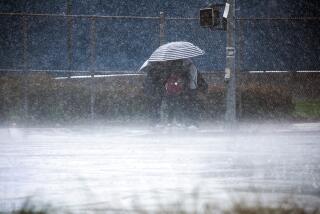School-Year Decision Met by Confusion : Education: Some see problems as L.A. district replaces summer vacation with two shorter breaks for most students.
Franklin High School counselor Jack Wright is worrying about how seniors will manage their college and financial aid applications.
Shelley Shapiro, a doctor at Harbor-UCLA Medical Center, is scrambling to make new child-care arrangements. Sally Horner, who operates a summer day camp in Pasadena, is trying to figure out how she will find college students who can staff her program.
For the record:
12:00 a.m. April 4, 1991 For the Record
Los Angeles Times Thursday April 4, 1991 Home Edition Metro Part B Page 3 Column 1 Metro Desk 3 inches; 80 words Type of Material: Correction
School calendar--A chart in Wednesday’s editions of The Times detailing the Los Angeles Unified School District’s 1991-92 calendar contained incorrect information about tracks B, C and D. The chart, based on information provided by the district, said students on those tracks would begin a vacation on July 1, 1992. That is the date the new school year begins for those students. Additionally, a story on the new calendar said most students would get two eight-week vacation periods, one in summer and one in winter. The vacation periods will be six to seven weeks each.
The decision to end the traditional school year in the nation’s second-largest school district has been hailed in some quarters and blasted in others. On the day after the Los Angeles Board of Education approved a new calendar for most of its 842 elementary, secondary and adult schools, the reigning response was confusion.
The confusion extends to what to call the new system, which replaces the long summer vacation at 640 schools with two shorter breaks, one in summer and one in winter, in effect putting campuses into some sort of year-round operation. Many of the remaining schools already are operating year-round to ease overcrowding. Students are divided into groups, or tracks, with one group on vacation at any given time and the school open throughout the year. But most schools following the new calendar will be on a single track in which all students attend at the same time, and there will be two eight-week periods when the campuses are closed. The system was chosen to better synchronize sessions among all district schools and to smooth the transition as burgeoning enrollments force more and more campuses into multitrack operation.
“Most people don’t . . . understand why we have to have it,” said Granada Hills High School junior Jon Iverson, who is afraid the short summer will cost him a job. “If we are all on a single track, there’s really no point.”
“So many of our parents, even our most active ones, are confused about year-round,” said Ray Roulette, assistant principal of the Westside’s University High School, which will be on single track. “They think we’ll be open all year and that students will be on all different schedules.
“We explain to them that this is just shifting vacation time around.”
For most students, school will start Aug. 19. There will be a winter break from Dec. 23 through Feb. 13. Then classes will resume for the spring semester, which will end June 30.
The long winter break in the single-track schedule brings some problems not yet resolved by district officials, especially in the high schools. Students taking advanced placement tests for college credit, for example, will have been in classes for much shorter time than most of their counterparts around the United States.
The winter break also means schools will be closed and guidance counselors and students on vacation during most of the crucial period for applying to college and seeking financial aid. “There is not another high school in the country on (that kind) of calendar, and for good reason,” said Helen Bernstein, president of United Teachers-Los Angeles.
She charged that the calendar was chosen primarily to mollify opponents of year-round schooling. District officials said the dates were picked after long study and discussion by a broad-based task force.
Wright, who helps many low-income and minority students get into college from Franklin in Highland Park, said the district has not figured out ways to overcome scheduling problems.
“Los Angeles Unified School District students will become further disadvantaged” in the competition for college, Wright said.
Board President Jackie Goldberg, an ardent supporter of year-round schools, said many of the problems could have been avoided if the district had put all campuses onto multitrack schedules immediately, avoiding the “down time” of single-track schedules.
“But we don’t have the political nerve to do that,” Goldberg said, referring to opposition from parents in the relatively uncrowded parts of the district, such as the Westside and the west San Fernando Valley.
She added that many problems will be resolved as more schools adopt multitrack schedules and day-care providers, operators of camps and summer enrichment programs and others modify their operations to match school calendars. She said she believes advantages of the new system, including the opportunities for students to take extra classes during the winter break, called intersession, outweigh the difficulties.
Members of the American Camping Assn., a national organization for professional summer camp operators, are worried about effects the change--along with the short notice--will have on their local operations.
“The biggest problem is going to be in finding staff,” said Horner, who runs the Tom Sawyer Day Camp, which attracts vacationing students from Los Angeles. “The colleges where we get our staff are not (going to change their schedules) just because the kids are off school.”
Increasing numbers of schools have been operating year-round for years, especially in such crowded areas as the Eastside, neighborhoods around downtown and cities southeast of Los Angeles. Administrators in longtime, multitrack schools say most people seem to have adjusted without problems.
For more than 10 years, all but one of the 26 Los Angeles Unified schools in the cities of Bell, Cudahy, Huntington Park, Maywood and South Gate have been on year-round schedules. Administrators at Cudahy’s Elizabeth Street Elementary School said most parents prefer the yearlong calendar to a traditional calender because it means smaller classes and enables more children to attend neighborhood schools.
Willene Cooper, chairwoman of the legislative Committee on School Overcrowding in the Southeast, said the area was forced to accept a year-round schedule or have children bused long distances to relieve overcrowding.
“We have adjusted quite well,” Cooper said.
Children and parents have better access to teachers all year, and students can retain knowledge better during vacation because breaks are shorter, administrators and parents said. They also said that parents adjust their vacations around the school calendar and find child care often with relatives.
“I haven’t heard anyone complain in seven or eight years,” said Pete Ferry, principal of South Gate Junior High.
On Tuesday, student reaction to the calendar approved by the board was mixed.
“It’s going to be hard to play without a crowd . . . most of the kids will be doing their own thing,” Jerome Jackson, a varsity basketball player at Fairfax High School, said of the winter break that cuts into some playing seasons.
“It just basically messes things up,” said Martinez Esteban, a junior at Banning High School, who is worried about jobs and vacations.
Gardena High School junior Melinda Spaeth saw some advantages.
“It’s better, because this way the kids don’t get bored,” Spaeth said. “You’re still going to school the same amount, but you get more of a mental break.”
Banning senior Eric Morrow offered some qualified optimism: “My overall feeling is I think it will work out for the most part.”
Ben Esfandi, a ninth-grader at Taft High School, said it just takes some getting used to.
“Ten years from now,” Esfandi predicted, “the students who have had this system all their lives will say, ‘Why should we ever change back?’ ”
Times staff writers Mathis Chazanov, Lee Harris, Amy Louise Kazmin, Deborah Schoch and Tim Waters contributed to this report.
SCHOOL DAYS
Following is the new year-round calendar for Los Angeles Unified School District in 1991-92.A total of 640 of the 842 campuses will remain on single-track schedules. Students at 162 campuses will be divided into four tracks: A, B, C and D (A follows the single-track calendar.) Three tracks attend school at one time, while the other track is on vacation.
SINGLE-TRACK AND TRACK A
Classes start Aug. 19
Dec. 23 to Feb. 13: Winter Recess
April 16 to 17: Spring Break
July 1 ‘92: Vacation begins
TRACK B
Classes start July 5
Sept. 30 to Nov. 8: Vacation
Dec. 23 to Jan. 1: Winter Recess
Feb. 14 and 17: Break
April 1 to May 13: Spring Recess
July 1 ‘92: Vacation begins
TRACK C
Classes start July 5
Aug. 19 to Sept. 27: Vacation
Dec. 23 to Jan. 1: Winter Recess
Feb. 18 to March 31: Spring Recess
April 16 to 17: Spring Break
July 1 ‘92: Vacation begins
TRACK D
Classes start July 5
Nov. 12 to Jan. 1: Vacation
April 16 to 17: Spring Break
July 1 ‘92: Vacation begins
Note: About 40 schools near downtown and in some cities southeast of Los Angeles, many of which have operated year-round for some time, will remain on a three-track system that uses a different calendar in which only two tracks attend school at any one time.
Compiled by Times editorial researcher Michael Meyers
More to Read
Sign up for Essential California
The most important California stories and recommendations in your inbox every morning.
You may occasionally receive promotional content from the Los Angeles Times.











